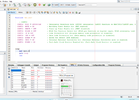Andy1845c
Active Member
Hello,
I spent some time this weekend getting back into ASM PIC programming after having not done anything with them for probably 10 years.
Can you set the configuration with a hex word still, or must you use the little wizard and copy/paste the block of setups into your ASM file?
I can't get it to work with the __config 0x3fdd for example, but works with the output of the configuration wizard.
I spent some time this weekend getting back into ASM PIC programming after having not done anything with them for probably 10 years.
Can you set the configuration with a hex word still, or must you use the little wizard and copy/paste the block of setups into your ASM file?
I can't get it to work with the __config 0x3fdd for example, but works with the output of the configuration wizard.


